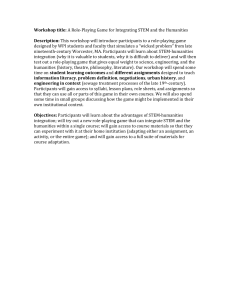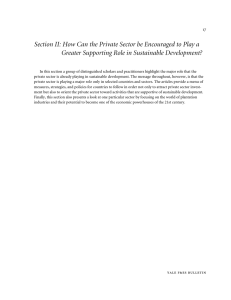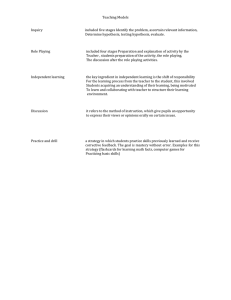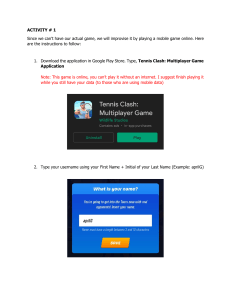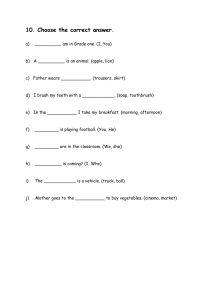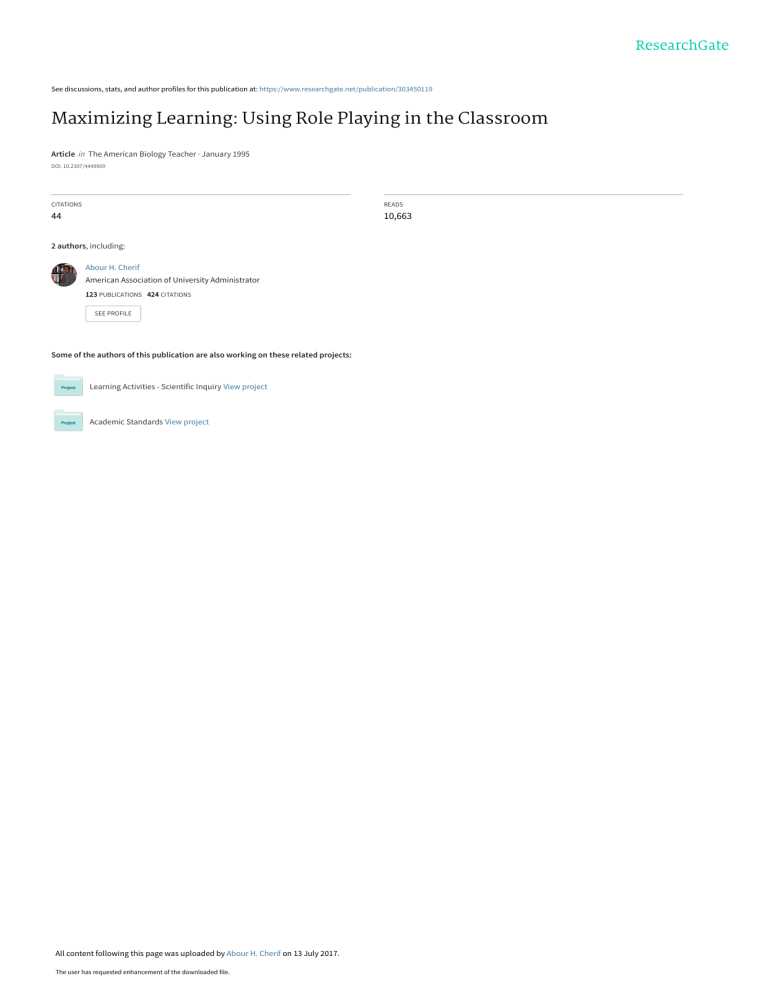
See discussions, stats, and author profiles for this publication at: https://www.researchgate.net/publication/303450119 Maximizing Learning: Using Role Playing in the Classroom Article in The American Biology Teacher · January 1995 DOI: 10.2307/4449909 CITATIONS READS 44 10,663 2 authors, including: Abour H. Cherif American Association of University Administrator 123 PUBLICATIONS 424 CITATIONS SEE PROFILE Some of the authors of this publication are also working on these related projects: Learning Activities - Scientific Inquiry View project Academic Standards View project All content following this page was uploaded by Abour H. Cherif on 13 July 2017. The user has requested enhancement of the downloaded file. Maximizing Learning: Using Role Playing in the Classroom Abour Cherif Christine Somervill M educators agree that effective teaching helps students to think critically, communicate effectively, learn self-discipline, develop an understanding of the self and others, and cultivates the perpetuation of self-education (Cherif & Adams 1993). Teaching methods that use students' experiences can help generate enthusiasm for active involvement in the learning process. One effective technique that encourages such participation is role playing. Role playing provides an opportunity for "acting out" conflicts, collecting information about social issues, learning to take on the roles of others, and improving students' social skills. Therefore, we believe that role playing plays an indispensable part in human development and offers a unique opportunity for resolving interpersonal and social dilemmas (Joyce & Well 1986). To emphasize the advantage of the role-playin,,,, teaching method, this paper provides information on teaching objectives, various levels of student involvement, and the importance of assessment, and lists some difficulties teachers should be prepared for in using this technique. Finally, we provide one example of role-playing activities in biotechnology that we have designed and implemented successfully in the classroom. attempts to help individuals find personal meaning within their social worlds, and to resolve personal dilemmas with the assistance of the social groups. In the social dimensions, it allows individuals to work together in analyzing social situations, especially interpersonal problems, and in developing decent and democratic ways of coping with these situations (Joyce & Well 1986, p. 241-242). ANY The Objectives of the Role-Ploy Teaching Approach Today's global, multicultural environment requires people to work cooperatively. Hence, teachers must provide their students with structural learning experiences to develop skills for work in the job climate (Gayford 1989). Role playing is helpful in meeting our teaching agenda, because it is a ". . .technique in which students spontaneously enact assigned roles in a given historical, literary, or contemporary situation in order to understand that situation more thoroughly" (Hawes & Hawes 1982, p. 193). Abour H. Cherif, PhD., is Professor of Biology and Science Education, and Christine H. Somervill, Ph.D., is Associate Academic Dean at Columbia College Chicago, 600 South Michigan Ave., Chicago, 160605. For example, by playing out how scientists appea to governments for research funds, students car experience a microcosm of the real world. Such rol€ playing provides an engaging opportunity to discus conflicting views on scientific issues, and also dem onstrates how social, political and economic issues change the direction and nature of science, while exploring the moral, ethical and social dimensions o our society. Joyce and Well (1986) identify four categories o teaching models: 1. Information-Processing Models, which teach meta cognitive learning, i.e. focusing on acquiring and organizing information and relating bodies of knowledge 2. Personal Models, which focus on the development of self-worth, self-awareness, persona responsibility, individual creativity and devel opment of interpersonal skills through thought interaction 3. Social-Interaction Models, which incorporate th( collective energy of the group, emphasize th( worth of cooperative learning, and promo& social skills including self-discipline, negotia tion, democracy, etc. 4. Behavioral Systems Models, which emphasize th( idea that in a structured environment, behavio, can be learned and modified through reinforce ment and constant feedback. Reinforcement anc feedback is incorporated in the role-playin teaching method via student interaction. Student Level of Involvement in the RolePlaying Process To make the role-playing teaching approach mos: productive, teachers should lead students towarc greater levels of involvement in the process 1-y, Role playing as a model of teaching has roots in both the personal and social dimensions of education. It 28 THE AMERICAN BIOLOGY TEACHER, VOLUME 57, NO. 1, JANUARY 1995 Table 1. Student level of independence in the role playing process (Cherif 1989). The Level of Problem To Be Involvement Solved Given Given Given Given Given Not Given II III IV V VI The Characters in the Play Given Given Given Given Not Given Not Given including them in planning the five factors that make up a typical role-playing situation: 1. 2. 3. 4. 5. The problem to be solved The characters to be played The roles to be followed Essential information to be gathered Procedures for the play to be adapted. At the first level of "Student Level of Involvement" in the "Role Play Teaching Model" as shown in Table 1, students carry out pre-assigned activities: They are actors for a scripted play. The educational value of the role-playing activities increases as the procedure encompasses greater levels of student involvement. For highest productivity, instructors should lead students toward Level 6, even if that level cannot ultimately be achieved. In teacher education, Cherif has student-teachers participate in the design and implementation of these six student levels of independence in the role-playing process. He observed that as the difficulty level increased, so did the amount of time, effort, and best of all, enthusiasm among the studentteachers. (A role-playing design at Level 1 is shown in Appendix 1.) The final level of student involvement is critical assessment. Assessment in Role Play The "after acting out" discussion is very important for students' cognitive and social development because it encourages understanding of the social and personal dynamics involved in reaching a conclusion. Hence, it is as important as the role playing itself. The teacher and students should explore how and why each person reached his or her decision, and whether this situation could have been approached in other ways (Joyce & Well 1986). Student involvement in the planning, implementation and assessment of role playing helps to counter some of the difficulties of teaching this method (for more ideas about assessment, see Appendix 2). However, the planning that role-playing teaching requires and the difficulties that may arise entail forethought by instructors. Role of the Essential Procedures for Characters Given Given Given Not Given Not Given Not Given Information Given Given Not Given Not Given Not Given Not Given the Play Given Not Given Not Given Not Given Not Given Not Given Many problems of role playing can be overcome by collaboration between teachers: sharing learned techniques and resource materials, and preparing for role playing in advance. Some of the problems encountered may be as follows: 1. Role playing requires a great deal of time and effort to be successful. The ". . .content of the problem, the solutions to the problem, the feelings of the role players, and the acting itself (as well as the "after acting out" analysis and discussion, which all serve to involve students in the role play)," are aspects that compete with each other for time and emphasis (Joyce & Well 1986). 2. It is sometimes difficult to generate enough characters, perspectives or useful resources for the study topic. 3. Role playing uses controversial topics—social, political, economic and ethical—because these issues are inseparable from our daily lives and therefore very close to the students' experiences. Controversy can be uncomfortable for many teachers. Furthermore, most of us (teachers) were never taught how to negotiate solutions to conflicts in the classroom, nor were we instructed on how to pass on conflict resolution skills to our students. The following model, combined with innovation, forethought and active planning with the students, may help to overcome these obstacles. A Successful Example of Role-Playing Activity in Biotechnology This role-playing activity is structured in the form of a city council meeting (e.g. Byers 1979). Seven groups consisting of three or four students are involved (this can be adapted for smaller classrooms), and the meeting is to decide which group would receive $10,000,000 for biotechnological research to better serve the entire community. Four of the groups are competing: the Industrial Community, the Medical Community, the Scientific Community, and the Problems That Teachers Face ROLE PLAYING IN THE CLASSROOM 29 Agricultural Community. Clearly, the interests of these four groups will overlap. The other three groups are the City Council, the public and the local news team. The City Council consists of a mayor, a press secretary, an alderman and a scientific advisor, who will oversee the proceedings and decide which community receives the funding. Citizens represent support for specific groups and public concerns, and the news team tests and summarizes the communities' arguments with pertinent questions. Remind the students that the objective is to provide a good argument about why their group deserves the money to use in biotechnological research. In addition to preparing for explanations and debate, each group must present opening and closing statements. Furthermore, the communities should be encouraged to "innovate and use a wide variety of maps, charts, graphs, diagrams and videos to enhance the persuasiveness of their presentation and arguments" (Arce 1992). Each group must have a good grasp of its own point of view, as well as an understanding of the opinions of the other communities. "Those who do not completely understand their adversary's point of view do not fully understand their own" (Bender 1986, p. 9). Also remind the students that the objectives in this role-playing activity are to help them develop: 1. Team work skills 2. Critical thinking and problem-solving skills 3. Breadth and depth of concepts and vocabulary of biotechnology and their application to life in our contemporary technological society 4. An understanding of the social, economic and environmental implications and limitations of biotechnological development 5. An awareness of their own attitudes, feelings and values and how they differ from others. Procedures for the Role Play I. Before the Enactment Procedures Prior to the enactment, each group must research its respective community to determine which facts to present to support its argument and prepare its materials for presentation. On the day of the enactment, but before the actual meeting, let each group meet privately to work on sharpening strategies. At this point the groups should be interviewed by the local news team. A few of the questions that could be asked by the media are: What kind of arguments will you present? Do you think you will be successful in obtaining the funding? If so, why? If not, why not? Are you willing and able to negotiate constructive solutions to conflicts with others? II. During the Enactment Procedures The enactment should begin with the mayor stating the regulations of the council meeting: length of opening statements, debate procedures and closing arguments. Every group should deliver its complete opening statement without interruption. Then the groups will make their arguments, question other groups, and answer questions from the media, citizens, and the mayor and his or her associates. Caution: The debate could become an emotional and verbal war revolving around how, for example, past money has been spent instead of how the present money will be used in enhancing research and development in biotechnology to the benefit of the citizens. The interesting part of this role play is that the arguments will overlap. (For specific advice to each group involved in this role-playing activity, see Appendix 3.) Acknowledgments We would like to take this opportunity to thank our colleagues in the Department of Science and Mathematics, Columbia College, for their suggestions, encouragement and support. We also thank those instructors who attended our presentation at the Third National Conference on College Teaching and Learning at Jacksonville, Florida (April, 1991) or at the 1992 Illinois Science Teachers' Association Conference (ISTA) in St. Charles, Illinois (Oct. 1-3). Their careful reading, thorough suggestions and thought-provoking comments led to significant improvement of the original manuscripts. Finally, but not least, we would like to thank the many teachers in the Chicago area and elsewhere, who have used this suggested roleplaying activity, and have given us much valuable feedback about their successes and difficulties. References Arce, G. (1992 March). Nuclear powered debate: Role playing with a reactor. The Science Teacher, pp. 45-50. Bender, D. (1986). Why consider opposing viewpoints. In J.S. Bach and L. Hall (Eds.), The environmental crisis. Opposing viewpoints series. St. Paul, MN: Greenhaven Press. Byers, C.R. (1979). Using a role-playing game to teach ecology. The American Biology Teacher, 41(9), 540-543. Cherif, A. & Wideen, M. (1992). The problems of transitions from high school to university science. B.C. Catalyst, 36(1):10-18. Cherif, A.H. & Adams, G. (1993). The essence of teaching. Forward To Excellence In Teaching and Learning, 1(1):5-7. Cherif, A.H. (1989). Ecology and education: Alternative prospective framework for ecology education. (Unpublished Ph.D. dissertation. Burnaby, British Columbia, Canada: Simon Fraser University. Gayford, C. (1989). A contribution to a methodology for ROLE PLAYING IN THE CLASSROOM 30 teaching and assessment of group problem solving in biology among 15-year-old pupils. Journal of Biological Education, 23(3), 193-198. Hawes, G.R. & Hawes, L.S. (1982). The concise dictionary of education. New York: Van Nostrand Reinhold Company. Joyce, B. & Weil, M. (1986). Models of teaching. Englewood Cliffs, NJ: Prentice-Hall, Inc. MacCormack, A.J. & Yager, R.E. (1989). Toward a taxonomy for science education. B.C. Catalyst, 33(1):16-17. Reissman, Q. & Rollnick, M. (1990). The use of role play with school students in Swaziland: A case study. Science Education International. pp. 5-8. Willis, S. (1993). Helping students resolve conflict. ASCD Update, 35(10):4-8. Appendix I The Role-Playing Design In designing the role-playing activity, the instructor should judge the extent to which students are ready for greater freedom in the activity. The following steps will help teachers in designing effective role-play activity. Step 1: Select a topic that is contemporary and important, organized around specific concepts, grounded in real life experience, and that will provide students with a challenging experience. Use companies and organizations that are local and/or wellknown to thê students. Step 2: Design the role play so that there are no right or wrong answers. The final decision will depend on the persuasiveness of the participants and the rationale of their arguments. From the beginning, make it clear to all students that each group will be graded based on the ". .quality of their research. . .the amount of creativity and innovation they use, and the clarity of their public presentation" (Arce 1992, p. 47). Also make it clear that each student must participate in the preparation of the enactment, speak during the enactment, and actively participate in the analysis and discussion. Step 3: Design the role play in a way that enables the students to research, plan and work cooperatively. Balance the groups' productivity by mixing higher, average and lower achievers into each group of the role play. Step 4: Give students a general fact sheet explaining the purpose of the role play and the group responsibility. Also distribute briefing sheets containing information on the part each student is to play in the discussion and the interests they must defend (Reissman & Rollnick 1990). There may be a need to match the fictional characters to the real character of the students in the classroom. For example, if the role of the chairman in the play requires a person who is confident, well experienced, informed, and knows how to keep people in line, then you should select the student who best fits these characteristics. Deliberately assigning students to play roles that could contrast with_their real personality can also be a very educational experience. In this case, design your role play to be a creative, cooperative endeavor that makes use of dynamic presentations. Step 5: Encourage your students to use diverse materials from a broad spectrum of sources such as "magazines, journals, books, and newspapers, as well as statements and position papers from a wide range of individuals, organizations, and governments" (Bender 1986, p. 10). Require students to use maps, diagrams, charts, figures, and other visual aids. A wide spectrum of sources helps students learn to be open to a variety of opinions and options (Bender 1986), plus it encourages innovation in their presentations and arguments. Encourage your students to practice their opening and closing statements and their key arguments beforehand. This is important in developing public speaking skills and in delivering smooth and coherent statements and arguments (Arce 1992). Step 6: It is very important to establish the proper environment for serious debate. Arrange the classroom to resemble a formal meeting hall, complete with (if possible) a microphone, pitcher of water or juice, etc. (Arce 1992). Step 7: Design some assessment questions for discussion after the role-play project is completed. Encourage the students to participate in the critique and analysis of the project. Appendix 2 Assessment in Role Play Using McCormack and Yager's (1989) taxonomy for science education as a framework for students' achievement, following are some examples of assessment criteria (Note: Many assessment questions could fall into more than one domain, depending upon how the questions are formed): I. Knowledge Domain—Students acquire knowledge of the subject and an understanding of relationships between the bodies of knowledge, and give reasons for their approach to solving the problem. Some questions are: What concepts did students learn and how well did they understand them? How well did the students integrate knowledge from different subject areas? To what extent did students demonstrate the understanding of multiple relationships of various bodies of knowledge? Were the students able to disprove or verify some of the supporting theories used in the role-playing activity? What kind of explanations did students offer for the relationship they observed and understood? II. Process Domain—Students learn how to collect, organize and analyze data; develop strategies for building rational arguments and thoughts; state problems and generate valid conclusions; participate in team-work; interpret meaning from the project. Some questions are: How did members of a given party compile data and information? Was there cooperation in putting the information together? How efficient was each group in presenting and communicating the collected data and information? Was their delivery of statements and arguments smooth and coherent? How well did the students use knowledge meaningfully? Did all members participate in the activity? III. Creative Domain—Students apply imagination and creative thinking to the project; cul- 32 THE AMERICAN BIOLOGY TEACHER, VOLUME 57, NO. 1, JANUARY 1995 tivate abilities to recognize, evaluate, and use data and information provided by the other parts of the role play; and learn to modify a given design as needed. Some questions are: In what new ways did students use objects and ideas generated during the enactment of the role-playing to enlarge their understanding? How imaginative were students in identifying relevant problems and solutions, and in conceptualising new ideas? IV. Attitudinal Domain—Students learn to listen closely and comprehend the other parts of the role play; learn cooperation in a group performance; and learn self-evaluation. Some questions are: How persuasive were group members in articulating their positions in order to change the attitudes of the others? How effectively did each group function? Did students' sensitivity and respect for others develop during the process? Did members of a given party demonstrate skills and abilities to resolve conflicts with others constructively? How might each group have functioned more effectively? V. Application and Connection Domain—Students learn to generate alternative approaches, problem-solving strategies, and solutions. Some questions are: Did they come up with practical and workable solutions? To what extent did the students utilize their personal experiences and collective group understanding in making decisions related to the activity? How well did the students integrate knowledge from different disciplines in problem-solving strategies? How well did the students learn to negotiate constructive solutions to conflicts? Appendix 3 Advice to the Various Groups Involved in This Role-Playing Activity The following instructions aregiven to the community groups prior to the role-playing exercise in order to help them formulate their initial arguments. The industrial Community You may be accused of being largely responsible for environmental problems. Some might argue that since you are responsible for the deterioration of the environment, the taxpayers should hesitate to give you a grant to fix your own mistakes. However, you might be able to use this to your advantage by arguing that funding would go toward a biotechnological clean-up effort. Perhaps you recently began a PR program to raise environmental awareness at the corporate level. You are a "for-profit" group; the others are nonprofit organizations that depend heavily upon donations from the community. Give examples of how your community has been involved in biotechnological development for many years, such as producing bread and beer, developing a better quality of yeast, and producing pharmaceuticals. Hence, by awarding the industrial community with the money, it could also benefit the other communities in the long run. The Science Community Without scientists there is no biotechnology. You could argue that since you serve all the other groups, you work with them to improve the overall quality of life. However, be aware that other groups could hire their own scientists. You must be able to explain why your particular group is better qualified. The Agricultural Community Since population growth and the use of pesticides are popular concerns, alternatives to current farming and food production methods must be developed using biotechnological advances. As a member of the agricultural community, you need the money to develop pest- and drought-resistant crops. However, other groups such as the scientists and industry might are that they are better equipped to do this kind of theoretical and applied research. Thus, you must have some specific ideas as to what you would do with the money. You should be aware of genetically engineered plants and products such as a new tomato that stays ripe and firm longer, a new variety of potatoes that doesn't absorb as much oil when deepfried, and many other genetically engineered vegetables with enhanced amino acid content. You should also be aware of porcine somatotropine, which makes pork less fatty, and bovine growth hormone (BGH), which boosts milk production in cows by 15% (albeit it is highly controversial). Some of these genetically engineered products have already been approved and some are awaiting approval by the Food and Drug Administration. Members of this community must ask themselves: Do consumers care about genetically engineered products? Will genetically engineered products have financial, social and medical consequences for farmers and the farming profession. Should government reports about the testing of genetically engineered products be trusted? Do genetically engineered products pose any environmental threat? The Medical Community You are going to face a tougher fight than any other group, so you need to be more competent at defending your statements. You might argue that you need the money to equip your local hospital to deal with AIDS and genetic diseases. To do this you need research facilities specifically designed to deal with biotechnological research and genetic diseases. Since you work directly with ill people, you have a better chance to conduct research and experiment with different kinds of genetic diseases. Be aware of the legal problems that might arise as the result of using patients as a source of research. The City Council The City Council hears all the arguments, questions the groups, and asks for input from the science advisor of the City Council. Then you will adjourn to weigh their merit and make a final decision. The science advisor of the City Council must analyze all of the positions and decide on their strengths and weaknesses. In order to make valid decisions, you must be willing to listen carefully, understand fully, and consider every variety of opinion from the mainstream of society—from unpopular and even despised opinions, to those that you are inclined to agree with (Bender 1986). Good advice comes from John Stuart Mill in his work, On Liberty: The only way in which a human being can make some approach to knowing the whole of a subject, is by hearing what can be said about it by persons of every variety of opinion, and studying all modes in which it can be looked at by every character of mind. No wise man every acquired his [or her" wisdom in any mode but this (Bender 1986, p. 10). The Citizen In real life, public rarely agrees on one viewpoint--especially on controversial issues surrounding biotechnology such as: BGH (Bovine Growth Hormone), which boosts milk production in cows; "Flavr Savr" a genetically engineered strain of tomato that stays ripe and firm longer; and Porcine Somatotropine, which makes pork less fatty. Thus, it is important for members of your group to express their own varied feelings about this issue, rather than agree on a consensual stance. Each member of this group must be very vocal—ask many questions and raise many concerns. After all, the public ultimately finances and consumes these products. Questions that might be considered by the members of this group are: What limits, if any, should be placed on genetic engineering? Should the U.S. government provide financial, political and technological support to genetic engineering? Should genetically engineered products be privately subsidized to encourage greater production and positive publicity? Should the government stop commercial approval for genetically engineered crops, but encourage further research until we better understand the potential risks they may pose to the environment? Appendix 4 Each group (committee) must submit written opening statement and a few key question that need to be raised during the debate to the instructor. Biotechnology, Fall Semester 1994 Opening Statement of -------------------------------- Committee Name of the Students: Key Questions That Need To Be Raised During The Debate 2. 3. 4. Appendix 5 Each group (committee) must submit written closing statement and a few key questions that should have be raised during the debate to the instructor. Biotechnology, Fall Semester 1994 o f Closing Statement C o m m i t t e e Name of the Students: Key Questions That Should Have he Raised During The Debate 1. 2. 3. 4. View publication stats
